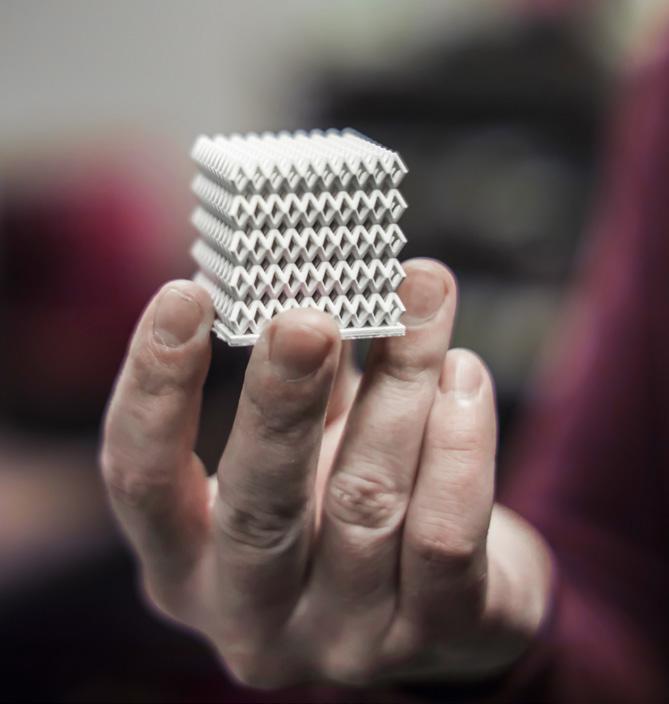
10 minute read
Erkka J. Frankberg Stella Zakeri, Nonna Nurmi, Michael Isakhani Zakaria, Antonia Ressler, Velimikko Mäkelä, Erkki Levänen: Ceramic additive manufacturing for industrial applications
from Materia 5/2024
Introduction
Ceramic additive manufacturing (AM) consists of a diverse pool of techniques allowing mouldless fabrication of complex and nearnet-shaped ceramic products through digital design. While the properties of the AM shaped ceramic materials are comparable to those manufactured using conventional powder processing methods, AM allows unprecedented freedom in design, such as mass customization of dense ceramic products, or products with designed porosity, with control over the pore size, size distribution and directionality of pores. AM techniques originally developed for polymer and metal products are now slowly becoming a viable option to mass customize or even mass produce ceramic products for selected industries, such as dental applications [1]. There are several reasons why AM techniques are specifically beneficial for ceramic manufacturing. First, ceramics (excluding glasses) are difficult to melt and cast into shape, as melting temperatures regularly exceed 2000 °C. Secondly, ceramics are brittle and intrinsically among the hardest materials known to us, making any type of subtractive manufacturing, such as grinding or machining, difficult and expensive. And, thirdly, conventional ceramic manufacturing is already based on powder processing. Therefore, any powder-based ceramic AM method has a good selection of raw materials available.
The cerAM project was built from this background with a holistic approach combining R&D knowhow on ceramic powder processing and light curable resin development (Millidyne Oy), 3D printer development, digital design and end user products (Planmeca Oy), and automation of the 3D printing processes (Wisematic Oy). The companies joined forces with Tampere University’s Ceramic Research group, a Finnish pioneer on AM of advanced ceramics and a veteran on powder-based ceramic processing technologies [1, 2]. Next, we introduce case studies and key results of the cerAM project, illuminating a path towards industrial applicability of ceramic AM.
Keraamien 3D-tulostus (cerAM) was a collaborative “co-innovation” project between industry and academia, funded by the Finnish governmental funding agency Business Finland (Grant No 6333/31/2021). Running between 1/2022 – 9/2024, and with an overall budget of ca. 3 M€, the project was coordinated by Tamlink Oy and consisted of a research project led by Tampere University, and three unique R&D projects by Planmeca Oy, Millidyne Oy and Wisematic Oy, with a holistic view towards commercialization of ceramic 3D printing. In addition, Valmet Oyj and Metso Oyj joined the project steering group as in-kind members. For more information, and the full-length project white paper, please visit www.ceram.fi.
Light curable resins for ceramic AM
The vat photopolymerization (VPP) techniques allow precise fabrication of detailed ceramic components with high dimensional accuracy and surface quality (Figure 1). VPP works by selectively curing layers of a photocurable ceramic resin using a light source, with a wavelength typically in the range of ultraviolet to visible light. The effectiveness of VPP in the ceramic manufacturing heavily relies on the formulation of ceramic resin, particularly the light curable binder component, which plays a crucial role in the printing process and subsequent post processing [2]. Binder in the ceramic resin acts as a carrier for the ceramic particles and provides structural support during printing and part handling. Optimizing the binder composition is essential to address several challenges in VPP, including the uniformity of layer deposition, minimizing shrinkage during curing, and achieving the desired mechanical properties in the final sintered parts. Results indicate promising binders, notably HDDA:TMPTA+ and PEG200DA:TMPTA+, which demonstrated low viscosity, moderate energy for curing, moderate volume shrinkage, and good mechanical properties. For applications where higher viscosity is acceptable, the HDDA+:PETTA+ formulation emerged as a strong candidate. Alternatively, for applications favoring methacrylates, PEG200DMA:PETTA+ formulation presents an attractive option, offering a balanced performance profile.
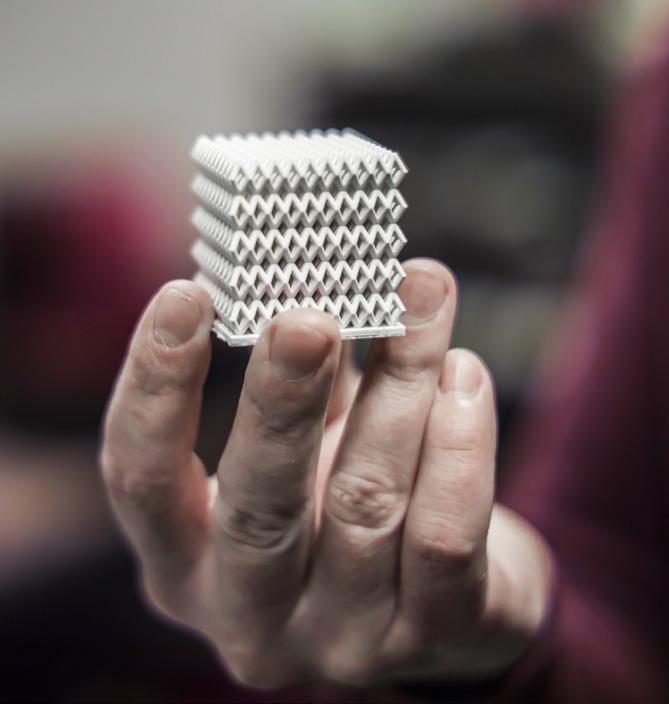
Planmeca Oy. While additive manufacturing of polymeric materials has already proven its value in many instances, dental milling is still considered to be the only manufacturing method for definitive ceramic restorations. The ability to cost-effectively manufacture full ceramic restorations using vat photopolymerization would be a breakthrough in the field of dental chairside manufacturing.
Aleksi Virta, Product Manager, 3D Printers
Towards more economical ceramic AM.
VPP printing provides an alternative solution to conventional CAD/CAM milling of ceramic green parts, such as dental crowns or medical implants for bone regeneration, with good part accuracy and low waste material generation [3] However, the VPP printing process requires the use of a significant amount of organic binder substances to support the printed 3D shape. The combined thermal pre-conditioning and debinding steps needed to remove the organic binders can take days, even up to 10 days to perform (Figure 2), and remains a major bottleneck in the VPP printing process [4].
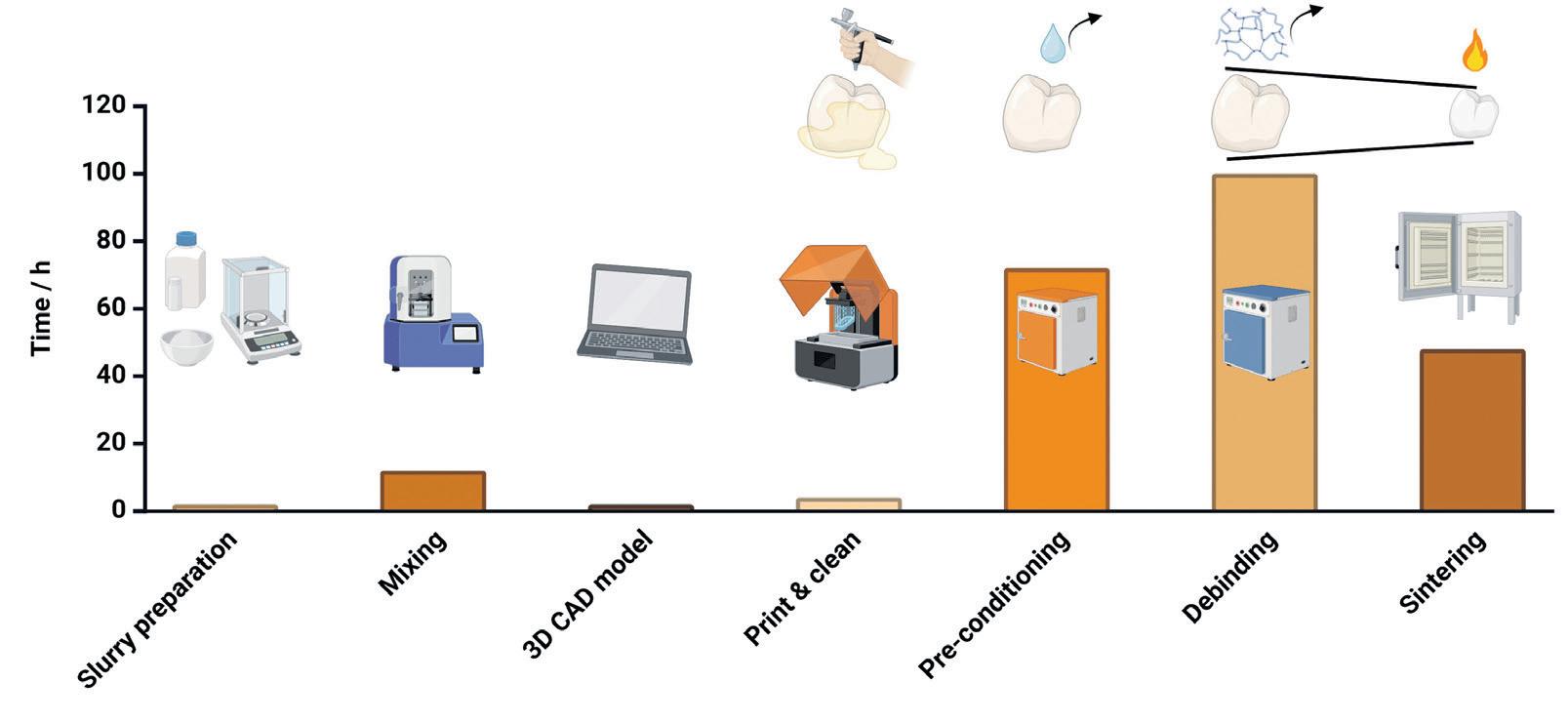
In cerAM, this challenge was tackled by using an alternative pre-conditioning process utilizing supercritical carbon dioxide (scCO2) extraction. The removal of 90 wt.% of the extractable organic content was successful with the use of scCO2 extraction within only 2 h, which in turn enabled reducing the total thermal post-processing time already by 30 h [5, 6]. The optimized scCO2 extraction did not cause delamination of the prints. The study concerning the influence of the process on the mechanical properties of sintered ceramic products is currently ongoing. Due to the apparent lack of alternative methods to thermal debinding, the results are highly interesting with identified potential for even more savings to the processing time.
Ceramic AM for improved quality of life
It is estimated that in Europe alone, 1,5 million bone augmentation procedures are required annually [7]. Obtaining an affordable and mass-customizable solution for maxillofacial bone augmentation procedures is essential for dental implants, for example when the patient does not have enough bone to attach the implantable screw to which the dental prosthesis can be attached. The AffordBoneS (EU-MSCA -project linked to the cerAM) solution for maxillofacial bone augmentation procedures is to treat these patients with biomimetic scaffolds obtained by using 3D printable calcium phosphate ceramics multi-substituted with biofunctional ions (mCaP). The VPP printed scaffolds exhibited uniform distribution of the trace elements, and they feature 3D-designed porosity predominantly ranging from 10 to 900 μm in diameter, with an average pore size of 546,25 ± 10,95 μm. The total porosity of scaffolds was 76,24 ± 1,32 vol% and an average wall thickness of 217,03 ± 8,98 μm, closely resembling the morphology and mechanical properties of natural cancellous bone tissue. The study demonstrates the feasibility of using custom made bioactive hydroxyapatite powders together with VPP technique (Figure 3) to design the porosity and properties of the bone scaffolds on demand, based on the requirements of individual bone defects [8].
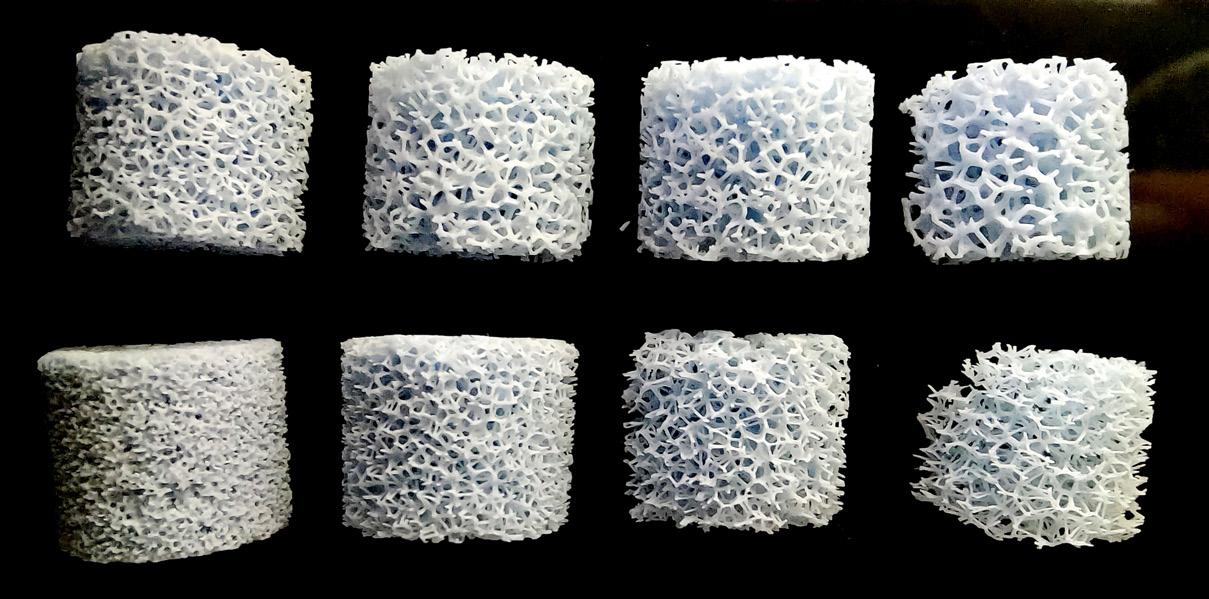
Wisematic Oy. The need for automation in ceramics AM was made clear during the project and, for example, developing automatic cleaning methods for the VPP prints has great potential for automation. It will shorten the time from a print to a product, reduce the need for human input, keep part quality more consistent and improve the operator safety.
Matti Suvanto, Mechanical Design Lead
Additive manufacturing of Nonoxide ceramics
Silicon carbide (SiC) ceramics are an advanced group of materials used in a wide range of industries, including electronics, high-temperature processing, aerospace, abrasive applications, nuclear power, and armor protection. Due to the challenging properties of SiC in solid-state sintering, the process of siliconizing, reaction bonding and reaction sintering has gained prominence as efficient and well-established technique to produce SiC ceramics also known as reaction bonded SiC (RBSiC).
Binder Jetting (BJT), a promising additive manufacturing (AM) technology, provides design flexibility with the ability to build 3D objects layer-by-layer. In comparison to other ceramic AM methods, BJT is much less restricted in size of the printed component, with latest commercial binder jetting machines exhibiting build volumes upwards of 1 m3 The cerAM research focused on the critical factors in BJT of SiC ceramics (Figure 4), investigating how different parameters affect the densification, microstructure, and properties of RBSiC. Findings suggest that achieving a homogeneous microstructure and small grain size are the keys to enhance the mechanical properties of RBSiC components [9]. The research clarified important aspects of the process-structure-property relationship in Binder Jetting of Reaction Bonded SiC (BJT-RBSiC) and highlights, for example, that the reaction sintering is affected by the layered structure of the 3D printed component.
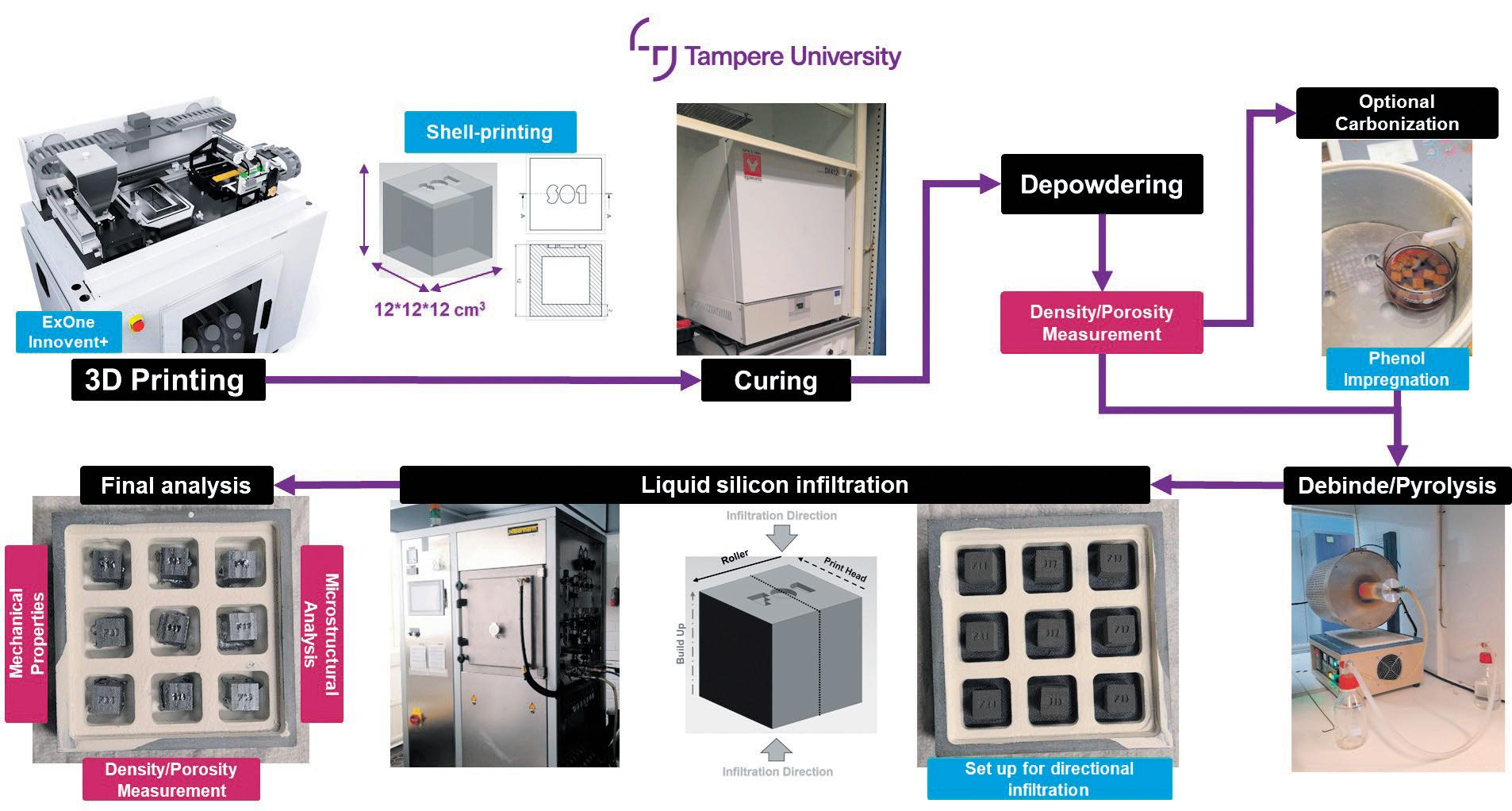
Summary and future outlook
Initially the cerAM project partners identified four major challenges in the way of industrial applicability of ceramic AM. Accordingly, the cerAM project has successfully: 1. Enabled the participating companies to understand where the high capital investments in light-based ceramic AM arise and to identify a path towards more affordable devices. 2. Enabled the reduction of thermal post processing time in ceramic VPP up to 20%, with the potential to further decrease the time up to 50%. 3. Clarified the role of VPP binders in determining the debinding behavior, leading to better control of the final properties of the ceramic components, such as mechanical strength. 4. Successfully identified ways to automate difficult and laborious sub-processes, such as cleaning of the parts after VPP printing. As an outlook to the future, there is a clear demand for more basic and applied research on the topic. However, as the technology is maturing, clear market and R&D opportunities can also be identified at the company level. The challenge regarding applicability of AM remains also in the attitudes at the factory floor. By simply 3D-printing existing and mass-producible ceramic products does not create value as such and ceramic AM will not soon replace existing mass production methods. Instead focus should be in creating new value with the unique benefits and opportunities that the ceramic AM technology offers in creating competitive advantage. Research on ceramic AM continues at full speed at the Ceramic Materials research group of Tampere University and the group will continue to support companies interested in the commercialization of ceramic AM. ▲
Millidyne Oy. Binder jetting is a ceramic AM method that has several benefits: large components can be printed at higher speed and with a broader selection of materials. However, lower densities and surface finish qualities remain drawbacks to this method. Therefore, new printable materials and binders are needed to overcome these challenges. Millidyne develops ceramic powders for thermal spraying and binder jetting.
Jari Knuuttila, CTO
References
[1] J. M. Suominen et al., Biomaterial Investigations in Dentistry, 6:1, 23-31 (2019).
[2] S. Zakeri et al., Additive Manufacturing, Volume 35, (2020) 101177.
[3] C. Valenti et al., Journal of Prosthetic Dentistry 132:2 (2022) 381-391.
[4] K. Wang et al., Ceramics International 46:2 (2020) 2438–2446.
[5] N. Nurmi et al., Additive Manufacturing 84 (2024) 104143.
[6] N. Nurmi, Master Thesis, Tampere University 2024.
[7] A. Hoornaert and P. Layrolle, Dental Implants and Bone Grafts, Book Chapter 8 (2020) 207-215.
[8] A. Ressler et al., Ceramics International 50 (2024) 27403-27415.
[9] M. I. Zakaria, Master Thesis, Tampere University 2024.
ERKKA J. FRANKBERG1,*, STELLA ZAKERI1, NONNA NURMI1, MICHAEL ISAKHANI ZAKARIA1, ANTONIA RESSLER1, VELIMIKKO MÄKELÄ2, ERKKI LEVÄNEN**1 1TAMPERE UNIVERSITY, MATERIALS SCIENCE AND ENVIRONMENTAL ENGINEERING, KORKEAKOULUNKATU 7, 33720 TAMPERE, FINLAND
2TAMLINK OY, HERMIANKATU 6 A, 33720 TAMPERE, FINLAND
*EMAIL: ERKKA.FRANKBERG@TUNI.FI, TEL: +358 46 921 9827
**EMAIL: ERKKI.LEVANEN@TUNI.FI, TEL: +358 40 849 0191










